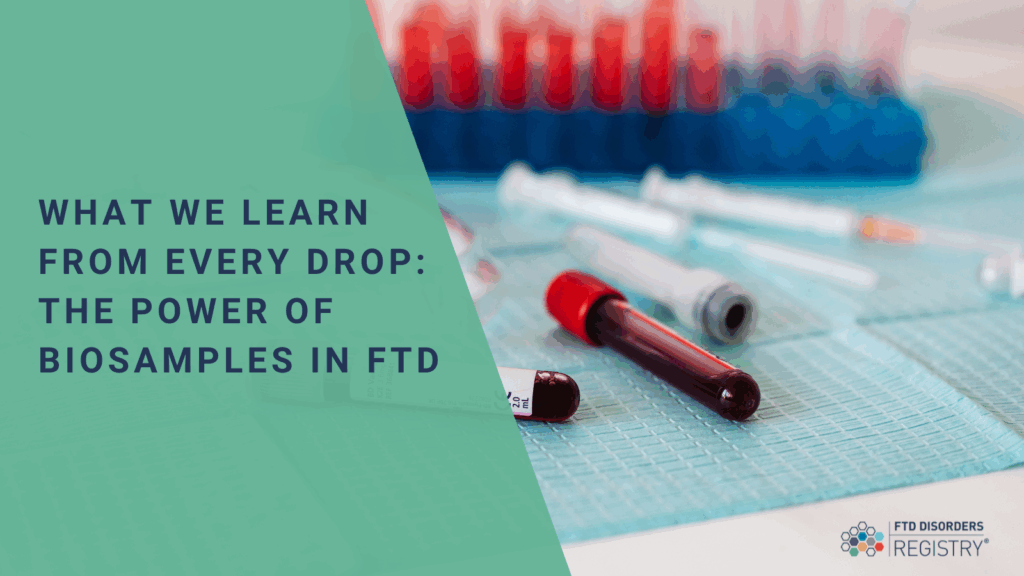PRESS & NEWS
What We Learn From Every Drop: The Power of Biosamples in FTD

Every biosample holds valuable information that brings us closer to earlier diagnosis and effective treatments for FTD.
Biosamples are small in volume but enormous in impact. In FTD research, the term “biosamples” refers to biological materials such as blood, saliva, skin cells, or cerebrospinal fluid collected through a spinal tap (also called a lumbar puncture). These samples contain measurable clues about how frontotemporal degeneration develops and changes over time. A single tube of blood, a cheek swab, or a vial of spinal fluid can reveal information that moves research forward.
For families living with an FTD disorder, the idea of contributing samples can feel personal. It can also feel abstract. What does a researcher learn from a blood draw or a spinal tap? Why do studies keep asking for biosamples? And how do these samples connect to real progress in understanding FTD?
The answer is that every sample adds one more piece to a complex puzzle. No study can stand alone. When researchers combine samples from different people, different subtypes, and different genetic backgrounds, the picture becomes clearer. Patterns emerge. Signals strengthen. New avenues open.
Why biosamples matter
Biosamples allow scientists to look directly at the biological processes behind FTD. They can measure proteins, track inflammation, identify genetic variants, and compare differences across disease stages. Cerebrospinal fluid collected through spinal taps is especially important because it can provide detailed information about protein changes that may signal disease progression.
These insights help researchers build the tools needed for earlier diagnosis and targeted treatments. They also help the research community understand how FTD varies across individuals. Two people with similar symptoms might have different underlying causes. Biosamples allow researchers to see those differences and design studies that respect the full range of FTD experiences.
How biosamples support future treatments
Most treatments under development for FTD target specific pathways or genes. Biosamples help researchers measure whether those therapies have an effect. They allow scientists to validate biomarkers that can show whether a drug is working before symptoms change.
Clinical trials depend on this. Without biomarkers, most trials would take longer, require far more participants, or struggle to detect meaningful change. Biosamples, including cerebrospinal fluid collected through spinal taps, make trials more efficient and more likely to succeed.
The role of research-ready communities
Biosample research thrives when more people are willing and able to take part. That is where the FTD Disorders Registry plays a vital role. By bringing together people with an FTD disorder, family members, care partners, and those at genetic or familial risk, the Registry helps researchers understand who is ready to participate and what types of studies are possible.
When more people enroll and share their backgrounds, researchers can design biosample studies that reflect the full FTD community. They can also more easily connect with individuals who may qualify for biosample collection or future clinical trials.
Numbers have power. A larger, more diverse group of research-ready participants strengthens every study that depends on biosamples.
Every contribution matters
Not every study asks for the same type of sample. Some require only a cheek swab. Others need blood, skin cells, or cerebrospinal fluid collected through a spinal tap. Some studies ask for repeated samples over time. No matter the method, each contribution supports discoveries that move us closer to effective treatments.
Every drop of blood, every swab of saliva, and every vial of spinal fluid helps reveal the biology of FTD. Together, these contributions are building the foundation for earlier diagnosis, more precise therapies, and a better future for every family affected by an FTD disorder.
If you are interested in learning more about research opportunities, including biosample studies, visit the Registry’s Find-A-Study page to explore current options and join the Registry to stay informed about new studies that become available.
Together we can find a cure for ftd
The FTD Disorders Registry is a powerful tool in the movement to create therapies and find a cure. Together we can help change the course of the disease and put an end to FTD.
Your privacy is important! We promise to protect it. We will not share your contact information.



